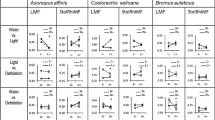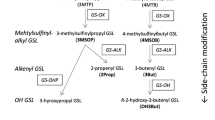Summary
Seed- and clonally-propagated plants of Big Sagebrush (Artemisia tridentata var.tridentata) were grown under atmospheric carbon dioxide regimes of 270, 350 and 650 μl l−1 and fed toMelanoplus differentialis andM. sanguinipes grasshoppers. Total shrub biomass significantly increased as carbon dioxide levels increased, as did the weight and area of individual leaves. Plants grown from seed collected in a single population exhibited a 3–5 fold variation in the concentration of leaf volatile mono- and sesquiterpenes, guaianolide sesquiterpene lactones, coumarins and flavones within each CO2 treatment. The concentration of leaf allelochemicals did not differ significantly among CO2 treatments for these seed-propagated plants. Further, when genotypic variation was controlled by vegetative propagation, allelochemical concentrations also did not differ among carbon dioxide treatments. On the other hand, overall leaf nitrogen concentration declined significantly with elevated CO2. Carbon accumulation was seen to dilute leaf nitrogen as the balance of leaf carbon versus nitrogen progressively increased as CO2 growth concentration increased. Grasshopper feeding was highest on sagebrush leaves grown under 270 and 650 μl l−1 CO2, but varied widely within treatments. Leaf nitrogen concentration was an important positive factor in grasshopper relative growth but had no overall effect on consumption. Potential compensatory consumption by these generalist grasshoppers was apparently limited by the sagebrush allelochemicals. Insects with a greater ability to feed on chemically defended host plants under carbon dioxide enrichment may ultimately consume leaves with a lower nitrogen concentration but the same concentration of allelochemicals. Compensatory feeding may potentially increase the amount of dietary allelochemicals ingested for each unit of nitrogen consumed.
Similar content being viewed by others
References
Allen LH (1984) Response of Vegetation to Carbon Dioxide. Progress Report No. 031. Plant Stress and Protection Research Unit, USDA-ARS Gainesville, FL
Alvarez-Cordero E, McKell CM (1979) Stem cutting propagation of Big Sagebrush (Artemisia tridentata Nutt.). J Range Mgt 32: 141–143
Cave GL, Tolley C, Strain BR, (1981) Effect of carbon dioxide enrichment on chlorophyll content, starch content and starch grain structure inTrifolium subterraneum leaves. Physiol Plant 51: 171–174
Croteau R (1984) Biosynthesis and catabolism of monoterpenes. In: Nes WD, Furler G, Tsai L (eds) Isopentenoids in Plants. Marcel Dekker, NY
Cure JD, Israel DW, Rufty TW (1988) Nitrogen stress effects on growth and seed yield of nonnodulated soybean exposed to elevated carbon dioxide. Crop Sci 4: 671–677
Fajer ED, Bowers MD, Bazzaz FA (1989) The effects of enriched carbon dioxide atmospheres on plant-insect herbivore interactions. Science 243: 1198–1200
Feeny P (1970) Seasonal changes in oak leaf tannins and nutrients as a cause of spring feeding by winter moth caterpillers. Ecology 51: 565–581
Feeny P (1976) Plant apparency and chemical defense. Rec Adv Phytochem 10: 1–40
Hansen J, Johnson D, Lebedeff S, Lee P, Rind D, Rusell G (1981) Climate impact of increasing atmospheric CO2. Science 213: 957–966
Jennings W, Shibamoto T (1980) Qualitative Analysis of Flavor and Fragrance Volatiles by Glass Capillary Gas Chromatography. Academic Press, New York
Kelsey RG, Shafizadeh F (1980) Glandular trichomes and sesquiterpene lactones ofArtemisia nova (Asteraceae). Biochem Syst Ecol 8: 371–377
Kelsey RG, Wright WE, Sneva F, Winward A, Britton C (1983) The concentration and composition of Big Sagebrush essential oils from Oregon. Biochem Syst Ecol 4: 353–360
Langenheim JH, Hall GD (1983) Sesquiterpene deterrence of a leaf-tying lepidopteran,Stenoma ferrocanella, onHymenaea stigonocarpa in central Brazil. Biochem Syst Ecol 11: 29–36
Lincoln DE, Couvet D (1989) The effect of carbon supply on allocation to allelochemicals and caterpillar consumption of peppermint. Oecologia 78: 112–114
Lincoln DE, Newton TS, Ehrlich PR, Williams KS (1982) Coevolution of the Checkerspot butterflyEuphydryas chalcedona and its larval food plantDiplacus aurantiacus; Larval response to protein and leaf resin. Oecologia 52: 216–223
Lincoln DE, Sionit N, Strain BR (1984) Growth and feeding respons ofPseudoplusia includans (Lepidoptera: Noctuidae) to host plants grown in controlled carbon dioxide atmospheres. Environ Entomol 13: 1527–1530
Lincoln DE, Couvet D, Sionit N (1986) Response of an insect herbivore to host plants grown in carbon dioxide enriched atmospheres. Oecologia 69: 556–560
Lindroth RL, Peterson SS (1988) Effects of plant phenols on performance of southern armyworm larvae. Oecologia 75: 185–189
Mabry TJ, Markham KR, Thomas MT (1970) The systematic Identification of Flavonoids. Springer, Berlin Heidelberg New York
Mattson W (1980) Nitrogen and herbivory. Ann Rev Ecol Syst 11: 119–162
Mihaliak CA, Couvet D, Lincoln DE (1987) Inhibition of feeding by a generalist insect due to increased volatile leaf terpenes under nitrate-limiting conditions. J Chem Ecol 13: 2059–2067
Morrow PA, Fox LR (1980) Effects of variation inEucalyptus oil yield on insect growth and grazing damage. Oecologia 45: 209–219
Nafziger ED, Koller HR (1976) Influence of leaf starch concentration on carbon dioxide assimilation in soybean. Plant Physiol 57: 560–563
Osbrink WLA, Trumble JT, Wagner RE (1987) Host suitability ofPhaseolus lunata forTrichoplusia ni (Lepidoptera: Noctuidae) in controlled carbon dioxide atmospheres. Environ Entomol 16: 639–644
Patterson DT, Flint EP (1980) Potential effects of global atmospheric carbon dioxide enrichment on the growth and competitiveness of C3 and C4 weeds and crop plants. Weed Science 28: 71–75
Picman AK (1986) Biological activities of sesquiterpenes lactones. Biochem Syst Ecol 14: 255–281
Picman AK, Elliott RH, Towers GHN (1981) Cardiac-inhibiting properties of the sesquiterpene lactone, parthenin, in the migratory grasshopper,Melanoplus sanguinipes. Can J Zool 59: 285–292
Rosenthal MD, Janzen DH (eds) (1979) Herbivores: Their Interaction with Secondary Plant Metabolites. Academic Press, New York
Scriber JM, Slansky F (1981) The nutritional ecology of immature insects. Ann Rev Entomol 26: 183–211
Sheldon JK, Rogers LE (1978) Grasshopper food habits within a shrub-steppe community. Oecologia 32: 85–92
Slansky F, Rodriguez JG (eds) (1986) Nutritional Ecology of Insects, Mites, Spiders and Related Invertebrates. Wiley-Interscience, New York
Spencer KC (ed) (1988) Chemical Mediation of Coevolution. Academic Press, San Diego
Strack D, Proksch P, Gulz PG (1980) Analysis of sesquiterpene lactones by high performance liquid chromatography. Z naturforsch 35: 915–918
Strain BR, Bazzaz FA (1983) Terrestrial Plant Communities. In: CO2 and Plants: The Response of Plants to Rising Levels of Atmospheric Carbon Dioxide. AAAS Selected Symposium 84. Westview Press, Boulder
Strain BR, Cure JD (eds) (1985) Direct Effects of Increasing Carbon dioxide on Vegetation. DOE/ER-0238, Department f Energy, Washington
Waldbauer GP (1968) The consumption and utilization of food by insects. Adv Insect Physiol 5: 229–288
Welch BL, McArthur ED (1981) Variation of monoterpenoid content among subspecies and accessions ofArtemisia tridentata grown in a uniform garden. J Range Manag 34: 380–384
Williams EW, Garbutt K, Bazzaz FA, Vitousek PM (1986) The response of plants to elevated CO2 IV. Two deciduous-forest tree communities. Oecologia 69: 454–459
Yoshioka H, Mabry TJ, Timmermann BN (1973) Sesquiterpene lactones. Univ of Tokyo Press, Tokyo
Author information
Authors and Affiliations
Rights and permissions
About this article
Cite this article
Johnson, R.H., Lincoln, D.E. Sagebrush and grasshopper responses to atmospheric carbon dioxide concentration. Oecologia 84, 103–110 (1990). https://doi.org/10.1007/BF00665602
Received:
Accepted:
Issue Date:
DOI: https://doi.org/10.1007/BF00665602




